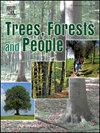Evaluation of protective devices for the direct seeding of longleaf pine (Pinus palustris)
IF 2.7
Q1 FORESTRY
引用次数: 0
Abstract
Most tree species, including longleaf pine (Pinus palustris Mill.; LLP) are established by planting seedlings during reforestation. Direct seeding could be a viable alternative; however, seed predation by various animals might be an impediment. While LLP are typically planted using nursery-grown plugs with high survival rates, planting these in certain sites may be difficult, and the appropriate genotype for a given site may not always be available. We expect that LLP seed and early seedling survival might reach acceptable rates when directly planted seeds are protected by shelters. We thus evaluated the effectiveness of degradable shelters (Seed Crowns™) for use in direct seeding of LLP. This project was carried out at two sites in middle Georgia and four sites on the Berry College campus near Rome, Georgia. At the middle Georgia sites, seeds were planted within shelters (no unprotected controls) across five subplots with varying numbers of planting spots at each site as a general test of field implementation. At Berry College, from 65 to 80 shelters were installed at each site along with 15 to 20 control spots (unprotected seeds). At the two middle Georgia sites respectively, 35 % and 77 % of seeds planted were living seedlings after ∼5 months and 52 % and 90 % of spots had at least one survivor. Across the Berry College sites after 5 months, sheltered seeds had an 86 %, 14 %, and 24 % improvement over controls in seeds (or seed coats) present, seedlings alive, and spots with at least one survivor, respectively. Taken together, these results suggest that direct seedling using these shelters may be a viable option for restoring longleaf pines when other considerations prevent or disfavor the use of containerized seedlings.
长叶松(Pinus palustris)直接播种防护装置评价
大多数树种,包括长叶松(Pinus palustris Mill.;LLP)是通过在重新造林期间种植幼苗而建立的。直接播种可能是可行的替代方案;然而,种子被各种动物捕食可能是一个障碍。虽然LLP通常使用苗圃生长的插头种植,存活率很高,但在某些地点种植这些可能很困难,并且特定地点的适当基因型可能并不总是可用的。我们预计,当直接播种的种子受到庇护所的保护时,LLP种子和早期幼苗的存活率可能会达到可接受的水平。因此,我们评估了可降解遮蔽物(种冠™)用于LLP直接播种的有效性。该项目在佐治亚州中部的两个地点和佐治亚州罗马附近贝里学院校园的四个地点进行。在格鲁吉亚中部的地点,种子被种植在避难所(没有无保护的控制),横跨五个小地块,每个地点有不同数量的种植点,作为现场实施的一般测试。在贝里学院,每个地点安装了65到80个庇护所,以及15到20个控制点(未受保护的种子)。在佐治亚州中部的两个地点,分别有35%和77%的种子在5个月后存活,52%和90%的地点至少有一个幸存者。5个月后,在贝瑞学院的各个地点,庇护种子在种子(或种皮)存在、幼苗存活和至少有一个幸存者的斑点方面分别比对照组提高了86%、14%和24%。综上所述,这些结果表明,当其他因素阻止或不赞成使用集装箱育苗时,使用这些庇护所直接育苗可能是恢复长叶松的可行选择。
本文章由计算机程序翻译,如有差异,请以英文原文为准。
求助全文
约1分钟内获得全文
求助全文
来源期刊

Trees, Forests and People
Economics, Econometrics and Finance-Economics, Econometrics and Finance (miscellaneous)
CiteScore
4.30
自引率
7.40%
发文量
172
审稿时长
56 days
 求助内容:
求助内容: 应助结果提醒方式:
应助结果提醒方式:


